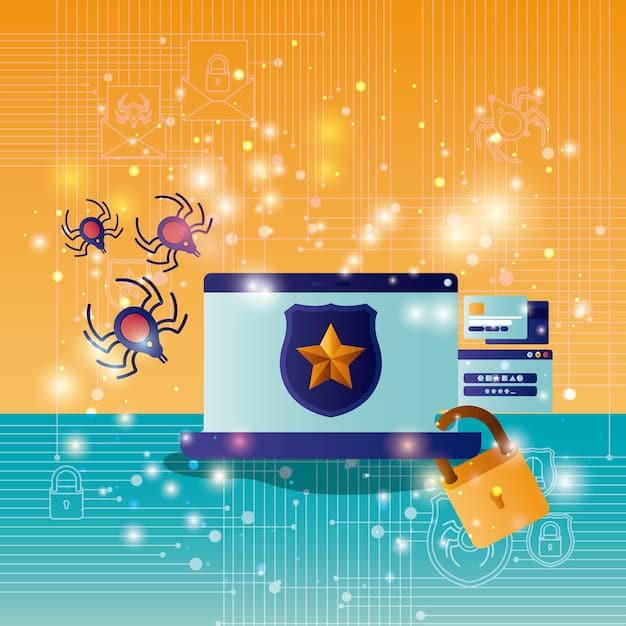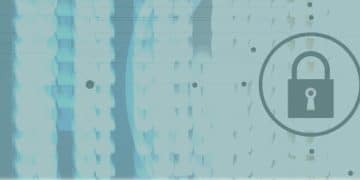The Dark Web: Risks and Safety Measures Explained

The Dark Web, a hidden part of the internet, poses various risks like illegal activities and data breaches; understanding these dangers and implementing robust security measures is crucial for staying safe.
Navigating the internet’s hidden corners can be risky. This article delves into **the Dark Web: Understanding the Risks and How to Stay Safe**, shedding light on its dangers and offering practical advice to protect yourself.
Understanding the Dark Web
The Dark Web is often shrouded in mystery. Let’s demystify what it is and how it differs from the regular internet.
The Dark Web is a subset of the Deep Web, which isn’t indexed by standard search engines. Unlike the surface web we use daily, the Dark Web requires specific software, such as Tor, to access. This anonymity makes it a haven for various activities.
How is it different from the Deep Web?
Many people confuse the Dark Web with the Deep Web. Here’s a quick clarification:
- Surface Web: Indexed by search engines like Google; accessible to everyone.
- Deep Web: Not indexed; includes content like online banking portals and subscription websites. It’s not inherently malicious.
- Dark Web: A small portion of the Deep Web, intentionally hidden and requiring special software to access.
Why use the Dark Web?
While often associated with illicit activities, some individuals use the Dark Web for legitimate reasons:
- Journalists and Activists: To communicate securely in countries with heavy censorship.
- Privacy Advocates: To maintain anonymity and protect their data.
- Law Enforcement: To monitor and investigate illegal activities.
The Dark Web isn’t inherently evil, but its anonymity attracts a high concentration of illegal activities.

Common Risks on the Dark Web
The Dark Web is rife with potential threats. Understanding these risks is the first step in staying safe.
The anonymity that defines the Dark Web also makes it a breeding ground for illegal activities and cyber threats. Let’s explore some common dangers you might encounter.
Illegal Marketplaces
One of the most significant risks is the presence of black markets:
- Drugs: Illegal substances are openly sold and traded.
- Weapons: Firearms and other weapons are available for purchase.
- Stolen Data: Credit card numbers, personal information, and leaked databases.
Malware and Hacking
The Dark Web is also a hub for malicious software and hacking services:
- Malware Distribution: Viruses, Trojans, and ransomware are frequently distributed.
- Hacking Services: Individuals offering services to hack into systems or accounts.
- Phishing: Fake websites designed to steal login credentials.
Exposure to Disturbing Content
The lack of regulation means you might encounter disturbing and illegal content:
- Graphic Violence: Extremely violent and disturbing content.
- Hate Speech: Content promoting hatred and discrimination.
- Illegal Activities: Content related to illegal activities like human trafficking.
Exposure to these risks can have severe consequences, from financial loss to psychological distress. Staying vigilant is crucial.
Protecting Your Identity
Protecting your personal information is paramount. Let’s explore some essential measures to safeguard your data.
Given the prevalence of data breaches and identity theft, securing your personal information is crucial, especially when venturing into less secure environments like the Dark Web.
Use Strong Passwords
Always use strong, unique passwords for every account:
- Length: Aim for at least 12 characters.
- Complexity: Use a mix of upper and lowercase letters, numbers, and symbols.
- Uniqueness: Avoid reusing passwords across multiple sites.
Enable Two-Factor Authentication
Two-factor authentication (2FA) adds an extra layer of security:
- How it Works: Requires a second verification method, like a code sent to your phone.
- Benefits: Makes it harder for hackers to access your accounts, even if they have your password.
Monitor Your Credit Reports
Regularly check your credit reports for suspicious activity:
- Why: Early detection of fraud can minimize damage.
- How Often: Check at least once a year, or consider using a credit monitoring service.
These measures provide a robust defense against identity theft and unauthorized access to your personal information.
Safe Browsing Practices
Adopting safe browsing habits can greatly reduce your risk. Let’s look at some essential practices.
Even if you’re just curious, safe browsing habits can significantly reduce your exposure to risks on the Dark Web and the internet in general. Here are some guidelines to follow.

Use a VPN
A Virtual Private Network (VPN) encrypts your internet traffic and hides your IP address:
- Benefits: Enhances anonymity and protects your data from eavesdropping.
- Considerations: Choose a reputable VPN provider with a no-logs policy.
Keep Software Updated
Regularly update your operating system, browser, and antivirus software:
- Why: Updates often include security patches that fix vulnerabilities.
- Automatic Updates: Enable automatic updates to ensure you always have the latest protection.
Be Wary of Links and Downloads
Exercise caution when clicking on links or downloading files:
- Verify Sources: Only download files from trusted sources.
- Scan Downloads: Always scan downloaded files with antivirus software before opening them.
- Avoid Suspicious Links: Do not click on links from unknown or untrusted sources.
Adhering to these practices can greatly minimize the risks associated with browsing the Dark Web.
Staying Anonymous
Maintaining anonymity is crucial on the Dark Web. Let’s discuss some key strategies for staying hidden.
One of the primary reasons people use the Dark Web is to remain anonymous. However, achieving true anonymity requires careful planning and execution.
Use Tor Browser
Tor (The Onion Router) is a browser designed for anonymous communication:
- How it Works: Routes your internet traffic through a network of relays, making it difficult to trace.
- Configuration: Use Tor’s default security settings and avoid changing them unless you know what you’re doing.
Avoid Personal Information
Never share personal information that could identify you:
- Names and Addresses: Avoid using your real name or address.
- Email and Phone Numbers: Use burner email addresses and temporary phone numbers.
- Social Media: Do not link your Dark Web activities to your real social media accounts.
Disable Scripts
Disable JavaScript and other scripts that can reveal your identity:
- Tor Browser Settings: Tor Browser has built-in settings to disable scripts.
- NoScript Extension: Consider using the NoScript extension for enhanced security.
Consistently applying these strategies will help you maintain a higher level of anonymity while using the Dark Web.
Legal Consequences
Engaging in illegal activities on the Dark Web comes with severe legal repercussions. Let’s examine these risks.
While anonymity might seem appealing, it does not shield you from the legal consequences of illegal activities. Law enforcement agencies actively monitor the Dark Web, and engaging in illegal behavior can lead to serious penalties.
Drug Trafficking
Buying or selling illegal drugs carries severe penalties:
- Federal Laws: Strict federal laws against drug trafficking.
- International Cooperation: Law enforcement agencies collaborate internationally to combat drug-related crimes.
Cybercrime
Engaging in hacking, phishing, or distributing malware is a serious offense:
- Computer Fraud and Abuse Act: Federal law that prohibits unauthorized access to computer systems.
- Penalties: Can result in hefty fines and long prison sentences.
Possession of Illegal Content
Downloading or possessing illegal content, like child pornography, is strictly prohibited:
- Child Protection Laws: Severe penalties for possessing or distributing child pornography.
- Global Efforts: International efforts to combat child exploitation.
It’s essential to understand that anonymity is not absolute protection, and engaging in illegal activities can have devastating legal consequences.
Conclusion
The Dark Web presents a complex landscape of risks and rewards, requiring a cautious and informed approach. By understanding the dangers and adopting robust safety measures, you can minimize your exposure to threats and protect your identity. Always prioritize safe browsing practices, maintain strong anonymity, and be aware of the legal consequences of engaging in illegal activities.
FAQ: Dark Web Safety
▼
The Dark Web is a hidden part of the internet that requires specific software like Tor to access, offering anonymity but also harboring illegal activities.
▼
Accessing the Dark Web itself is not illegal, but engaging in illegal activities such as buying drugs or hacking is a crime.
▼
Use a VPN, the Tor browser, avoid sharing personal information, and disable scripts to enhance your anonymity online.
▼
Risks include exposure to illegal marketplaces, malware, phishing scams, and disturbing content, potentially leading to financial or psychological harm.
▼
Some use it for legitimate reasons like secure communication, privacy, and circumventing censorship, while others use it for illegal activities due to its anonymity.
Conclusion
Understanding the Dark Web’s risks and implementing robust safety measures is crucial for staying safe online. Prioritize anonymity, practice safe browsing, and be aware of legal consequences to protect yourself.





